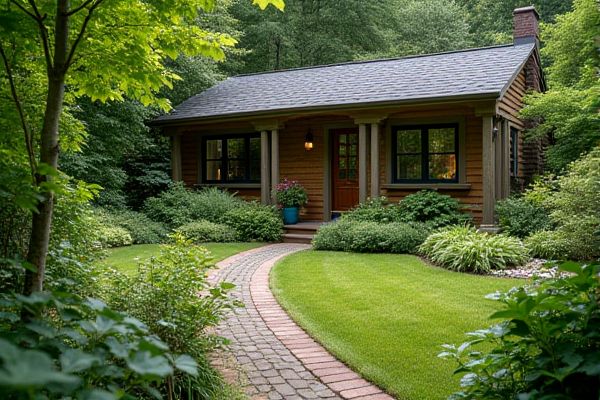
A perennial bed offers long-lasting, low-maintenance plants that return year after year, creating a stable and sustainable garden environment, while an annual bed features colorful, seasonal plants that complete their life cycle in one growing season, providing vibrant change but requiring replanting each year. Explore more insights on how to choose the best planting strategy for your garden needs in the rest of the article.
Table of Comparison
| Feature | Perennial Bed | Annual Bed |
|---|---|---|
| Plant Lifespan | Plants live multiple years | Plants complete life cycle in one season |
| Maintenance | Lower; less frequent planting | Higher; requires yearly replanting |
| Soil Impact | Improves soil structure over time | May require more soil amendments annually |
| Cost | Higher initial cost, lower long-term cost | Lower initial cost, higher long-term cost |
| Design Flexibility | Limited yearly changes | Highly adaptable to seasonal styles |
| Growth Time | Slow establishment, matures over years | Fast growth and bloom within one season |
| Examples | Hostas, Daylilies, Peonies | Marigolds, Petunias, Zinnias |
Understanding Perennial Beds vs Annual Beds
Perennial beds feature plants that return year after year, reducing the need for replanting and providing long-term garden structure. Annual beds require planting new crops each season, offering flexibility to change plant varieties and colors based on your preferences. Choosing between perennial and annual beds depends on your garden maintenance goals and desired seasonal variety.
Key Differences Between Perennial and Annual Gardens
Perennial beds contain plants that live for multiple years, providing long-term structure and reducing the need for replanting each season, whereas annual beds require planting new crops every year for seasonal color and variety. Perennial gardens often establish deeper root systems, enhancing soil stability and nutrient cycling, while annual gardens typically promote quick growth and rapid bloom cycles. Soil management differs as perennial beds benefit from ongoing enrichment, whereas annual beds need frequent tilling and nutrient replenishment to support successive plantings.
Pros and Cons of Perennial Plant Beds
Perennial plant beds offer the advantage of long-term growth, reducing the need for annual replanting and providing consistent soil stabilization. However, they require careful initial planning and may take several seasons to fully establish, potentially limiting immediate visual impact compared to annual beds. Perennials also demand less maintenance and watering over time but can be less flexible in design changes than annual plant beds.
Advantages and Disadvantages of Annual Flower Beds
Annual flower beds offer vibrant color and variety throughout the growing season due to the wide selection of species that complete their life cycle in one year. They require replanting each year, which can increase labor and cost compared to perennial beds but also allows for seasonal design flexibility and quick garden refreshment. However, annual beds may demand more water and nutrients, leading to higher maintenance compared to the generally more drought-tolerant and low-maintenance perennial beds.
Maintenance Needs: Perennial vs Annual Beds
Perennial beds require less frequent maintenance since plants return year after year, reducing the need for replanting and soil preparation compared to annual beds. Annual beds demand consistent upkeep, including soil amendment, regular planting, and ongoing watering through growing seasons. Effective maintenance planning for perennial beds involves pruning and mulching, while annual beds necessitate intensive seasonal care to sustain vibrant blooms and healthy growth.
Design Flexibility: Seasonal Color vs Lasting Structure
Perennial beds offer lasting structure with consistent root systems and foliage, providing year-round architectural interest and less frequent replanting. Annual beds deliver high design flexibility, allowing for vibrant seasonal color changes and theme adjustments each growing season. Combining both can balance enduring garden frameworks with dynamic, colorful displays throughout the year.
Cost Considerations for Perennials and Annuals
Perennial beds typically require a higher initial investment due to the cost of mature plants but offer long-term savings as they return year after year with minimal replanting. Annual beds tend to be less expensive upfront yet incur ongoing costs since you must purchase and plant new seeds or seedlings each season. Your budget can benefit from balancing both, using perennials for durable structure and annuals for seasonal color and variety.
Best Plant Choices for Each Bed Type
Perennial beds thrive with plants like hostas, daylilies, and peonies that return year after year, reducing maintenance and providing lasting structure. Annual beds offer vibrant, season-long color through plants such as marigolds, petunias, and zinnias, ideal for quickly changing your garden's appearance. Your choice depends on whether you want low-maintenance, long-term planting or dynamic, colorful displays each growing season.
Environmental Impact and Sustainability
Perennial beds enhance environmental sustainability by reducing soil erosion, improving water retention, and promoting biodiversity through stable root systems that enrich the soil over time. Annual beds typically require more frequent tilling and replanting, which can lead to increased soil disturbance, higher water use, and greater input of fertilizers and pesticides. Choosing perennial beds supports carbon sequestration and long-term ecosystem health, making them a more eco-friendly option for sustainable gardening.
Choosing the Right Bed for Your Garden Goals
Perennial beds provide long-lasting structure and reduced maintenance by featuring plants that return year after year, ideal for gardeners seeking sustainability and consistency. Annual beds offer vibrant seasonal color and flexibility, perfect for those who enjoy experimenting with different plant varieties and designs each growing season. Selecting between perennial and annual beds depends on your preference for long-term investment versus seasonal variety, as well as garden size, climate, and maintenance capacity.
 homyna.com
homyna.com